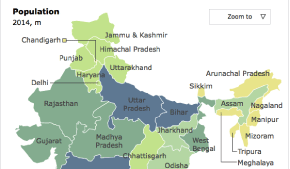Image may be NSFW.
Clik here to view.
THE wheel at the centre of India’s flag is an appropriate symbol. In the world’s largest democracy politics ceaselessly turns yet seldom moves, and then rather slowly. Take West Bengal, the most populous of the four Indian states (plus a tiny union territory) that are holding local elections over the next six weeks.
Many of the state’s 92m residents think that the local ruling party, the Trinamool Congress (TMC), has brought scant improvement since taking power in 2011. Fresh scandals include the capture on video of party officials taking bribes, and the deadly collapse of a hideous, costly and long-delayed flyover in the state capital, Kolkata. Yet the TMC’s dispensing of gifts, such as a claimed 2.5m bicycles, and its system of patronage and persuasion backed by street toughs, appears likely to win the party another five years in office.
Grey zone
Together with those in West Bengal, elections in Assam, Tamil Nadu, Kerala and the union territory of Puducherry will see more than 160m people invited to cast their vote, a fifth of India’s overall electorate. Yet in all but one of these contests polls suggest that the outcomes, which are to be announced together on May 19th, will follow predictable patterns.
In the prospering southern state of Tamil Nadu the dominant local party also looks set to shrug off corruption charges and return to office. Like West Bengal’s TMC under Mamata Banerjee, the AIADMK is run with tight discipline by a veteran female politician, Jayaram Jayalalitha, a former film star who has served five times as the state’s chief minister.
Neighbouring Kerala appears likely to opt for a different sort of continuity. Since the late 1970s power in the state has alternated between two enduring coalitions. Barring upsets, polls suggest that the pattern will be repeated, with the communist-led Left Democratic Front likely to oust the United Democratic Front led by the Congress party, the once-formidable national electoral vehicle of the Gandhi dynasty. Congress’s great rival, the Bharatiya Janata Party (BJP), in office nationally under the prime minister, Narendra Modi, has sought to make inroads in Kerala. But though its Hindu-nationalist rhetoric has won converts, its effectiveness is limited in a state in which nearly half the voters are either Muslim or Christian.
The state of Assam in the north-east also has large minority populations. Yet a history of animosity between native Assamese and incomers, particularly recent Muslim migrants from Bangladesh, provides more fertile soil for communal grudges. Congress’s incumbent local leader, Tarun Gogoi, who has served as Assam’s chief minister since 2001, is 81 years old. Despite his personal popularity, many are ready for a change.
Mr Modi’s party strategists have exploited these weaknesses with skill and determination, helped by the defection of one of Mr Gogoi’s most promising lieutenants. Top BJP ministers and officials, including Mr Modi, have assiduously courted the state. On the campaign trail Amit Shah, the party’s grizzled president and a man viewed as a Hindu-nationalist hardliner, has frequently brandished the sectarian card. At a rally in November he accused Congress, absurdly, of harbouring a “secret plan” to surrender Assam to Bangladesh.
Mr Shah’s language has softened lately. He now merely pledges that a BJP-led state government would seal the border with Muslim-majority Bangladesh “so not even birds can fly across”. Yet repeated insinuations of a looming Muslim menace, including from Congress pandering to its supposed “Muslim vote bank”, have been effective. Some pollsters are predicting a big win in Assam for the BJP.
Victory there would be extremely welcome to Mr Modi. Since the BJP’s crushing defeat of Congress in the national elections of May 2014, the party’s fortunes have been mixed. Last year it lost badly to local parties in both the capital, Delhi, and in Bihar, India’s third-most-populous state.
Those setbacks put paid to hopes of the BJP making inroads in Parliament’s upper house, the Rajya Sabha; its rotating membership is indirectly elected, apportioned according to parties’ success in state elections. Congress and other opposition parties have used the upper house to thwart legislation passed by the lower house, where the BJP holds a big majority.
The BJP hopes to capture Assam, make inroads in states in this round, and then do even better in next year’s election in Uttar Pradesh, the most populous state with over 210m people. Yet even then the upper house’s brake on the wheel of change will not be released. The BJP and its allies hold just 64 of the Rajya Sabha’s 245 seats. Under India’s constitution seats change hands at a stately pace, with one-third of the membership retiring every two years. In other words, by the time Mr Modi’s first term runs out in 2019 he will, in the best of circumstances, be running in place.
